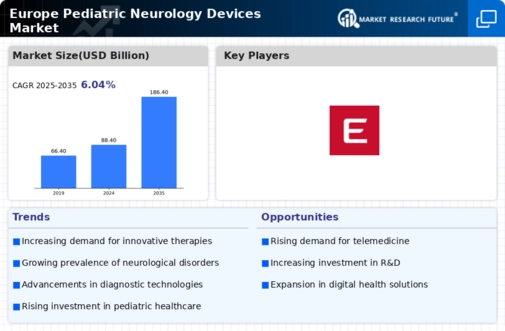Market Share
Europe Pediatric Neurology Devices Market Share Analysis
The market for pediatric neurological devices in Europe is always shifting, so businesses that want to meet the needs of kids with neurological issues must be very smart about where they put their market shares. This part talks about different tools used in pediatric neurology, so it needs certain strategies to work. One important strategy is to make sure that new goods are made with kids in mind. Companies put a lot of money into research and development to make neurology tools that are safe for kids, the right size, and packed with high-tech features that meet the needs of kids with neurological diseases. New products made with kids in mind are helping to gain more market share. It is very important to follow the rules set by medical law. The companies that make neurology goods make sure that they follow the rules set by the European Commission for pediatrics. These rules take into account the special mental and physical needs of children. When you follow the rules, the gadgets become more reliable. This makes doctors and parents believe them more, which is good for market share. Working closely with baby neurologists is a key way to get a bigger share of the market. Companies hire experts in the field to find out more about what each customer wants and is interested in. Not only do these relationships help make new products, but they also build trust, which makes the products more popular and the market share grow. Companies make goods to help kids with epilepsy, cerebral palsy, and muscle diseases because kids can have a lot of different neurological conditions. You can reach more people and meet the needs of different groups of young patients if you make a range of gadgets that are made to treat different illnesses. Neurology tools for babies needs to look good and be simple to use. Businesses try to make tools that look good, have simple settings, and are bright and fun. Healthcare professionals and parents can easily recognize and choose a brand if it has child-friendly branding and makes sure users have a good experience. This has an impact on market share. A big way to get more kids with brain problems is to show parents and other adults who care for them how to use the tools properly and what they can do for kids. Businesses spend money on programs that teach kids and their parents by giving them tools, training materials, and online help. Parents are more likely to buy a product if they know more about it. This is good for market share. It is very important that marketing attempts are made with kids in mind. Some of the places where companies market their goods are at events for kids' health, on social media, and on kid-safe websites. Targeted marketing helps the market share grow by making the product more obvious to parents and people who work in health care. It is very important to show good clinical data and proof that neurology products for kids work well and safely. To get permission for kids to use their products, companies do a lot of research and clinical testing. When the devices have solid proof, doctors and parents believe them more. This is good for market share because it means more people will buy them. Companies depend on being able to reach people all over the world in order to get a bigger share of the market. This means making sure that neurology tools for kids are available in a lot of places in Europe. The global market for neurology goods for kids is growing thanks to things like making deals with distributors in a smart way, following international rules, and marketing in several languages. Brain study projects for kids are actively backed by business. They need to work together with study centers, elementary schools, and universities to do this. Brain research grants not only help infant neurology move forward, they also make companies stars in the field, which is good for market share. To adapt to changes in the healthcare system, companies are putting more effort into linking their pediatric neurology goods with telemedicine systems. Telehealth systems that work with other systems make it easier to keep an eye on patients and talk to them, which draws healthcare workers who want to be more linked. As the field of pediatric neurology care changes, this mix helps to increase market share.




Leave a Comment